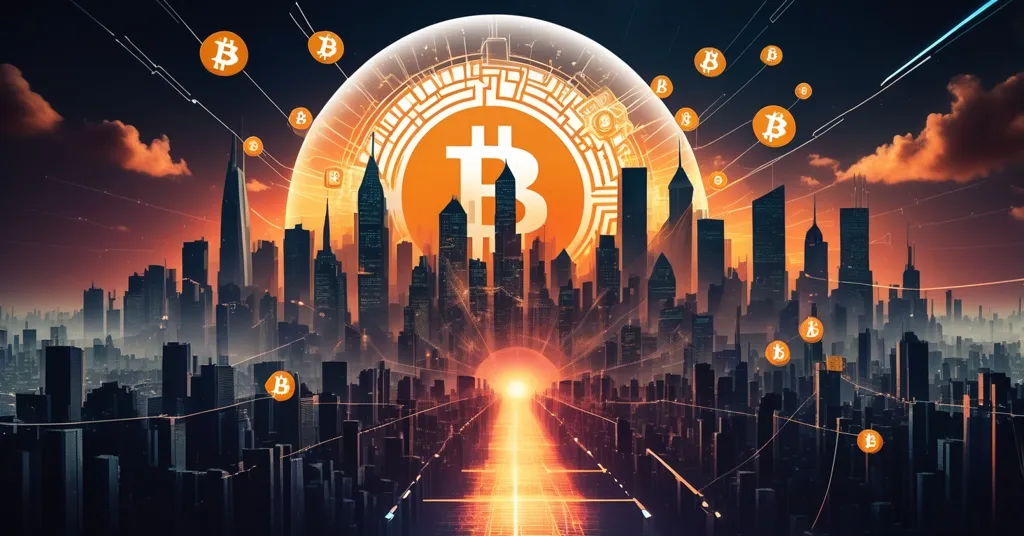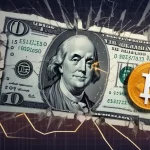Trump Bitcoin Endorsement Rumors Spark Debate as Bitcoin Solaris Presale Hits Millions

Trump Bitcoin Endorsement Rumors Ignite Debate as Bitcoin Solaris Presale Surges Past Millions
Speculation over former U.S. President Donald Trump potentially endorsing Bitcoin has set the crypto community ablaze with chatter, but while the market obsesses over political soundbites, a new altcoin, Bitcoin Solaris (BTC-S), is quietly racking up over $5.8 million in its presale. With Bitcoin stuck in a frustrating rut, lacking the spark to push past familiar price points, investors are pivoting to projects like BTC-S that promise cutting-edge tech and hefty returns. This dual narrative of political uncertainty and altcoin ambition captures the chaotic, opportunity-rich nature of the crypto space right now.
- Trump’s Crypto Stance: Rumors of a Bitcoin endorsement by Trump fuel endless speculation, though his flip-flopping history keeps everyone guessing.
- Bitcoin’s Stagnation: The king of crypto remains steady but uninspired, creating a vacuum for altcoin hype.
- Bitcoin Solaris Momentum: With $5.8 million raised from 12,800+ users, BTC-S pitches itself as a high-performance blockchain with a potential 150% ROI at launch.
Trump’s Crypto Rollercoaster: Hype or Real Impact?
The crypto world loves a good drama, and Donald Trump is serving it up on a silver platter. One minute, he’s trashing Bitcoin as a “scam”—a direct quote from a 2021 Fox Business interview—claiming it undermines the dollar. The next, he’s talking up U.S. crypto mining in 2023, suggesting America must dominate the space to counter foreign powers like China. These mixed signals have traders and enthusiasts dissecting every tweet and speech for clues about a possible endorsement. A pro-Bitcoin stance from a figure as polarizing as Trump could jolt market sentiment, potentially driving prices skyward overnight. But let’s not kid ourselves—his track record, detailed in various analyses of Trump’s Bitcoin stance, shows more interest in headlines than policy substance. Predicting his next move feels like betting on a tornado’s path: thrilling, but ultimately a gamble.
Political influence on crypto isn’t just a Trump thing—it’s a reminder of how much decentralized tech still bends to centralized power. In the U.S., a key market for adoption, regulatory clarity remains a pipe dream. The SEC’s ongoing crackdowns on exchanges and token projects, coupled with uncertainty ahead of upcoming elections, amplify the stakes of any high-profile commentary. If Trump—or any political heavyweight—pushes a pro-crypto agenda, it could accelerate mainstream acceptance, as discussed in broader conversations about the impact of political figures on Bitcoin. Flip that coin, and harsh rhetoric might spook investors, triggering sell-offs. For now, this sideshow is more noise than signal, but it underscores a hard truth: even Bitcoin, the poster child of financial freedom, isn’t immune to the whims of suits in Washington.
Bitcoin’s Sleepy Grind: Stability or Stalemate?
While political theater grabs attention, Bitcoin itself is playing the quiet game. Hovering between $25,000 and $30,000 for much of 2023, based on CoinGecko data, BTC isn’t crashing—but it’s not inspiring either. Transaction volumes on-chain have dipped compared to the 2021 bull run, and long-term holders seem content to sit tight, per Glassnode metrics. This isn’t a crisis; it’s a holding pattern. Without major catalysts like regulatory green lights or macroeconomic shifts—think inflation cooling or interest rate cuts—Bitcoin feels like it’s waiting for permission to wake up.
From a Bitcoin maximalist lens, this stagnation is a feature, not a bug. BTC doesn’t need to dance to every market whim; it’s digital gold, a store of value built on unbreakable security and scarcity. With only 21 million coins ever to exist, its resilience through economic storms is why it remains the bedrock of crypto. But let’s not sugarcoat it—hodlers chanting “to the moon” are getting restless. When the king of decentralization idles, eyes wander to flashier contenders promising innovation and quick gains. Enter altcoins, and specifically, Bitcoin Solaris.
Beyond Trump: The Broader Regulatory Shadow
Trump’s hot takes might dominate headlines, as seen in widespread reports on Trump Bitcoin endorsement rumors, but the bigger picture for crypto in the U.S. is a regulatory minefield. The Securities and Exchange Commission (SEC) continues its warpath, slapping lawsuits on major exchanges like Binance and Coinbase over unregistered securities claims. Meanwhile, legislative gridlock in Congress means no clear framework for digital assets is on the horizon. With the 2024 election looming, candidates’ stances on blockchain tech could sway voter bases—especially younger, tech-savvy ones who see crypto as a middle finger to traditional finance. This isn’t just about one man’s endorsement; it’s about whether the U.S. will foster innovation or strangle it with red tape, a topic explored in studies on crypto regulation’s impact on Bitcoin and altcoins.
For Bitcoin and the broader market, this uncertainty is a double-edged sword. On one hand, a hostile environment could crush smaller projects and dampen adoption. On the other, it fuels the very ethos of decentralization—pushing developers and investors to build systems that outlast government overreach. As champions of freedom and disruption, we see this tension as the crucible where crypto’s future is forged. But while we wait for clarity, capital doesn’t sit still—it flows to opportunities like Bitcoin Solaris that aren’t waiting for bureaucratic blessings.
Bitcoin Solaris: Tech Promise or Presale Hype?
Breaking Down the Tech Stack
Bitcoin Solaris (BTC-S) isn’t content to be just another altcoin riding a hype wave—it’s positioning itself as a high-performance blockchain with serious chops for decentralized finance (DeFi) and non-fungible tokens (NFTs). For the uninitiated, DeFi means financial tools like lending or trading without banks, built directly on blockchain. NFTs are unique digital assets, often art or collectibles, that prove ownership via the chain. BTC-S claims it can process up to 10,000 transactions per second (TPS) with a 2-second finality—meaning deals close almost instantly. Compare that to Bitcoin’s measly 7 TPS or Ethereum’s still-climbing numbers, and the appeal is obvious. They’re running a dual-consensus model, mixing Proof-of-Work (Bitcoin’s energy-hungry mining method) with Delegated Proof-of-Stake, where token holders vote for network validators to boost efficiency. It’s a hybrid aiming for both security and speed.
Digging deeper, BTC-S supports smart contracts—self-executing code for apps—written in Rust, a programming language prized for speed and bug resistance. They’re integrated with Solana, a competing blockchain known for scalability, hinting at cross-chain potential for DeFi hubs. Their network also rotates validators and “slashes” bad actors by docking their tokens, a penalty to keep things honest. On paper, this tech stack screams ambition. But real-world performance often trips over whitepaper dreams—just ask Solana users who’ve faced outages during peak congestion. We’re rooting for innovation, but let’s not pretend untested systems are flawless out the gate, a concern echoed in community discussions on Bitcoin Solaris feedback.
Presale Numbers and Tokenomics
The presale buzz for BTC-S is undeniable. Over 12,800 users have piled in, raising more than $5.8 million. At Phase 10, tokens are priced at $10, with a launch target of $20, dangling a potential 150% return on investment for early buyers. To break that down, drop $1,000 now, and if it hits launch price, you’re looking at $2,500—if the project sticks the landing. Their token distribution, or tokenomics, seems designed to avoid the dump-and-run scams that plague new coins. With a fixed supply of 21 million BTC-S tokens, 66.66% are reserved for mining rewards over 90 years, incentivizing long-term commitment. Another 20% went to the presale, with smaller slices for liquidity, development, community perks, staking, marketing, and team/advisors. They’ve also passed audits by Cyberscope and Freshcoins, and the team is KYC-compliant, meaning their identities are verified to deter fraud. Active communities on Telegram and X add to the grassroots vibe, critical for any project’s staying power, as highlighted in detailed Bitcoin Solaris presale reports.
“Bitcoin Solaris isn’t just another altcoin with flashy branding. Bitcoin Solaris has a working product stack, real scalability, and a developer roadmap that’s already delivering results.”
Mobile Mining and Accessibility
One of BTC-S’s most intriguing hooks is the upcoming Solaris Nova App, set to let users mine tokens using just smartphones or laptops. Mining, traditionally, means running complex calculations to validate blockchain transactions, often requiring pricey, power-hungry hardware. Making it mobile could open doors for everyday folks, especially in regions where high-end gear isn’t an option. Imagine earning crypto while sipping coffee—no rig, no fuss. But before we crown this a game-changer, let’s flag the pitfalls. Mobile mining can drain batteries, wear out devices, and pose security risks if apps aren’t airtight. Past projects like Pi Network hyped similar accessibility but stumbled on scalability and trust. If BTC-S nails this, it’s a win for inclusivity. If not, it’s just another broken promise.
Risks and Reality Checks
“Insiders are calling it the ‘wealth engine’ of this cycle.”
That label sounds seductive, especially with Bitcoin snoozing and Trump’s crypto musings feeling like a circus, as debated in various community threads on Trump endorsement rumors. BTC-S backs it up with live features like the Solaris Power Exchange for mining rentals and a vision for 2025 dominance. But let’s slam the brakes on the hype train. Altcoin presales are a notorious Wild West. For every Solana that soars, there are Bitconnects—infamous scams that vanished with millions. Chainalysis reported that over 20% of 2022 token launches showed signs of fraud or rug pulls, where devs disappear with the cash. The 150% ROI for BTC-S isn’t a promise; it’s a speculative carrot. Even with audits, long-term viability is unproven, and liquidity post-launch could tank if demand fizzles. We’re all for disruption, but blind faith in shiny new tokens is how wallets get burned. Do your damn homework.
“Trump may be making waves with his crypto stance, but investors chasing the next opportunity aren’t waiting on speeches. They’re moving capital into platforms with working tech, proven traction, and a clear vision.”
Bitcoin vs. Altcoins: Maximalism Meets Innovation
As Bitcoin maximalists, we’ll always argue that BTC is the unassailable core of this revolution—a decentralized fortress against fiat tyranny. Its stability, even when boring, proves its worth as digital gold. It doesn’t need 10,000 TPS to change the world; it needs to be unbreakable, and after 15 years, it damn well is. Yet, we can’t ignore that altcoins like Bitcoin Solaris fill gaps BTC doesn’t touch. Speed, scalability, and niche use cases—think microtransactions in gaming NFTs or DeFi yield farming—are where these upstarts shine. The ecosystem thrives when Bitcoin anchors trust and altcoins experiment with what’s next. It’s not a zero-sum game; it’s effective accelerationism in action, pushing finance toward freedom one wild idea at a time.
Key Takeaways and Questions on Trump, Bitcoin, and Bitcoin Solaris
- What’s behind the Trump-Bitcoin endorsement buzz?
Trump’s contradictory statements—dissing Bitcoin as a scam in 2021, then backing U.S. crypto mining in 2023—keep markets guessing about a potential game-changing endorsement. - Why is Bitcoin stuck in a rut despite its dominance?
Hovering at $25,000-$30,000 with no major catalysts like regulatory shifts or economic triggers, Bitcoin lacks the momentum for a breakout, frustrating eager hodlers. - What makes Bitcoin Solaris a standout in the altcoin crowd?
Boasting 10,000 TPS, a dual-consensus model, mobile mining via the Solaris Nova App, and Solana integration, BTC-S targets DeFi and NFT scalability with a solid tech foundation. - Is the Bitcoin Solaris presale hype justified with $5.8 million raised?
The numbers and audits check out, with a tempting 150% ROI at launch, but presale success doesn’t guarantee longevity—scams and flops litter altcoin history, so caution is key. - Should investors pivot from Bitcoin to altcoins like BTC-S during slow periods?
Diversifying into altcoins offers growth potential, but Bitcoin’s proven track record as a store of value remains unmatched; altcoins carry higher risks of volatility and fraud. - How does political uncertainty beyond Trump affect crypto’s future?
U.S. regulatory battles, from SEC lawsuits to election outcomes, could either boost adoption with clear rules or stifle innovation with overreach, impacting Bitcoin and altcoins alike.
Navigating the crypto jungle means sifting through political noise, market lulls, and presale promises with a sharp eye. Trump’s influence, Bitcoin’s slow churn, and bold plays like Bitcoin Solaris are all threads in a messy, thrilling tapestry. As advocates for decentralization and financial rebellion, we’re here to champion real tech and call out the garbage. Whether 2025 brings policy bombshells or blockchain breakthroughs, one thing’s clear: the fight for freedom in finance is just heating up. Stay skeptical, stay curious, and keep pushing the boundaries.



